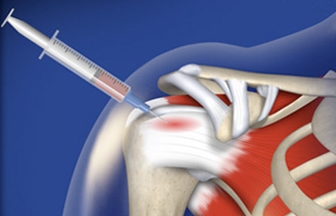Regenerative Injection Therapy with Platelet Rich Plasma
Cutting edge treatment for difficult injuries

What is Platelet Rich Plasma (PRP)?
Platelet Rich Plasma or PRP is blood plasma with concentrated platelets. The concentrated platelets found in PRP contain huge reservoirs of growth factors that are vital to initiate and accelerate tissue repair and regeneration. These growth factors initiate connective tissue healing: bone, tendon and ligament regeneration and repair, promote development of new blood vessels, and stimulate the wound healing process.
Commonly treated conditions
Knee
- Patellar tendinosis (Jumper’s Knee)
- Quadriceps tendinosis
- Chronic Iliotibial band syndrome
- Ligament sprains
Elbows
- Lateral epicondylitis (Tennis Elbow)
- Medial epicondylitis (Golfer’s Elbow)
- Chronic elbow sprain (Pitcher’s Elbow)
Ankle/Foot
- Chronic ankle sprains
- Chronic Achilles tendinosis
- Chronic Peroneal tendon partial tear and tendinosis
- Plantar fasciitis
Shoulder
- Rotator cuff - partial tears and tendinosis
- Long head of biceps tendinosis
Hand/Wrist
- Chronic thumb sprain
- Chronic wrist sprain
How does PRP Therapy work?
To prepare PRP, a small amount of blood is taken from the patient. The blood is then placed in a centrifuge. The centrifuge spins and separates the patient’s own platelets from red blood cells, automatically producing the PRP. The entire process takes less than 15 minutes and increases the concentration of platelets and growth factors up to 500%. The PRP is then injected under direct ultrasound guidance into the damaged area, stimulating an accelerated healing response in the affected tendon or ligament. Ultrasound guidance is used to be sure that the PRP is injected with pinpoint accuracy into the damaged areas to maximize effectiveness.

What are the potential benefits?
Patients can see a significant improvement in symptoms in chronic, difficult to treat injuries. This may eliminate the need for more aggressive treatments such as long term medication or surgery as well as a remarkable return of function.
What can be treated?
PRP injections can be performed in tendons and ligaments all over the body and can also be used to treat chronic muscle injuries.
How many treatments are necessary and how often is this therapy administered?
While responses to treatment vary, most people will require 1 to 2, rarely as many as 3-4 sets of injections. If more than one injection is needed, each set of treatments is spaced approximately 4 to 6 weeks apart. There is no limit to the number of treatments you can have, the risks and side effects do not change with the number of injections.
Is PRP right for me?
If you have a tendon or ligament injury and traditional methods have not provided relief, then PRP therapy may be the solution. The procedure is less aggressive and less expensive than surgery. There will be an initial evaluation with Dr. Ooi to see if PRP therapy is right for you.
I’ve heard about Cortisone Shots, is this the same?
Studies have shown that cortisone injections may actually weaken tissue. Cortisone shots may provide temporary pain relief and stop inflammation, but they do not provide long term healing. PRP therapy heals and strengthens these tendons and ligaments, strengthening and thickening the tissue up to 40% in some cases.
Are there any special instructions?
You are restricted from the use of non-steroid anti-inflammatory medications (Motrin, Aleve, etc.) one week prior to the procedure and throughout the course of treatments. Initially the procedure may cause some localized soreness and discomfort. Ice and heat may be applied to the area as needed. The first week after the procedure, patients will typically start a rehabilitation program with home exercises or physical therapy.
How soon can I go back to regular physical activities?
PRP therapy helps accelerate tendons and ligaments regeneration but it is not a quick fix. This therapy is stimulating the growth and repair of tendons and ligaments, and requires time and rehabilitation. Through regular visits, your doctor will determine when you are able to resume regular physical activities.
Does insurance pay for PRP?
Because PRP is relatively new and cutting edge, most insurance companies and Medicare do not pay for PRP injections. There are some companies that may cover partial reimbursement after pre-authorization. It is always a good idea to check with your health insurance company.
